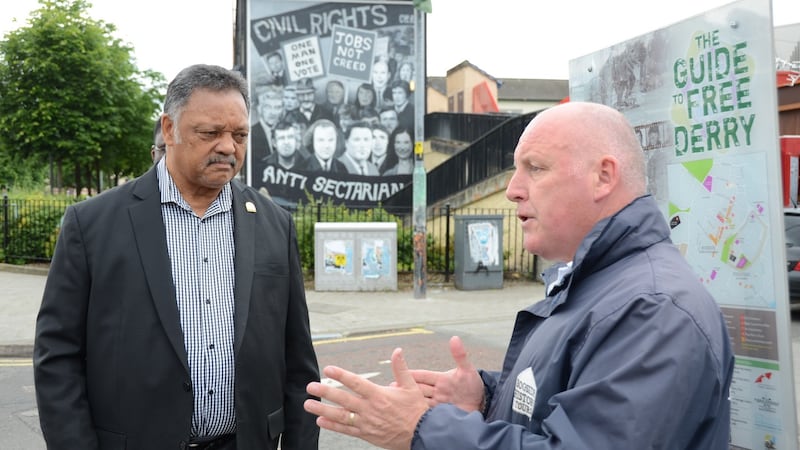On every one of Paul Doherty’s tours of Derry’s Bogside, there is a moment when the group falls silent.
“I explain who I am, what I do, and then I say my Da was one of the victims of Bloody Sunday,” says Doherty, whose father was among the group of civilians killed by British soldiers during a civil rights march on January 30th, 1972.
Sometimes the reaction is shock, or disbelief – “They’ll go, ‘you serious?’,” Doherty says. Others have chosen his tour because they want to hear his family’s story.“That’s who we are, we can’t change that, but it means people know they’re getting a personal account of what happened.”
“We have goosebumps,” says Italian visitor Michela Rocchi.“Something like this isn’t really tourism. We’ve come here to learn more about the story.”
This desire to learn more about Northern Ireland's recent past is something Derry City and Strabane District Council (DCSDC) is keen to tap into. Work has recently begun to develop the area's first "peace tourism" strategy, as part of the EU's Peace IV programme. It will allow the council to "present its shared history and the journey towards peace and reconciliation".
This will involve bringing together many of those already working to attract tourists and those interested in the city’s role in peacebuilding.
“The idea is about clustering together experiences and tourism providers – whether that’s accommodation, cafes, restaurants,” says Linzi Simpson, council tourism development project officer.
Economic impact
Though in its early stages, Simpson is in no doubt the appetite for peace tourism is there. She says the potential is not just in terms of bringing in tourists, and the accompanying economic impact. “In terms of the peace and reconciliation side, the potential for the engagement across different communities is huge.”
People who come here want to hear the stories, they want to visit the Bogside, they want to see the murals
This aspect is being explored by Maeve McLaughlin, project manager of the Bloody Sunday Trust’s conflict transformation and peacebuilding project. Her long-term aim is to establish a conflict transformation hub in Derry.
“We have all of these experiences and learning and mistakes and some key outcomes here, but when you look at conflict transformation it’s not really focused in Derry,” says McLaughlin.
She cites not just the impact of the Bloody Sunday Justice Campaign (seeking a new inquiry), the Saville Report and the subsequent public apology for Bloody Sunday from then British prime minister David Cameron, but also Derry’s success in resolving parading issues.

She said all this leadership experience has never been fully captured or utilised, but this is starting to change. A key element is simply ensuring that stories are told, she said.
“People who come here want to hear the stories, they want to visit the Bogside, they want to see the murals, they want to go to Free Derry Corner and they want to hear people’s experiences.
They probably think they're going to get a sugar-coated version of what happened
“It’s bigger than just numbers and bed nights. We’re telling the story of Derry in a different way and we’re telling a story that hasn’t really been told before, and people are buying into it.”
Historic city walls
This is not confined to nationalist communities: within Derry’s historic city walls, the Siege Museum tells the story of the 1689 siege and offers tours of the adjoining Memorial Hall, the headquarters of the Apprentice Boys of Derry (a loyal order similar to the Orange Order).
Yet the nationalist Bogside area, as a focal point for many events of the Troubles, remains the best-known of Derry's peace tourism attractions. The Museum of Free Derry has welcomed more than 33,000 people through its doors this year. Doherty set up his company, Bogside History Tours, five years ago, and employs two other guides.
Another of the guides, John McKinney – whose brother William was also among the victims – has just left a group of young people from Belfast. "They probably think they're going to get a sugar-coated version of what happened," says McKinney. "Half of them were nearly crying just now.
“One of them said to me, ‘Would you ever forgive the soldier who killed your brother?’, and I told them how my Ma forgave them but my Da didn’t.”
This personal insight is key. The first name on the memorial is that of Patrick Doherty, a 31-year-old father of six children – among them our guide, Paul Doherty.
“It depends what kind of form I’m in, but I do show people [where he was killed]. I respect that people want to hear it first hand,” he says.
“It’s a hard thing to do, and it isn’t, because I’m so passionate about telling the story of what happened – enjoy isn’t the right word, but I suppose I do thrive on telling people.”
Family connection
“I’m very proud to do it,” says Doherty. “The family connection is obviously what is there, but in the wider context I’m very proud of Derry as a city which has developed brilliantly in the last 20 years,
“I’m also proud to tell about my role in the campaign and about receiving the apology from Cameron and the cloud lifting over Derry, and where we’re going today.
Doherty is in no doubt. “I do think the Bogside is a sleeping giant in terms of Derry. Political tourism, peace tourism – it’s just going to grow.You don’t need to run after people to drag them to Derry any more, they’re coming in their droves, and they’re going to keep coming.”











